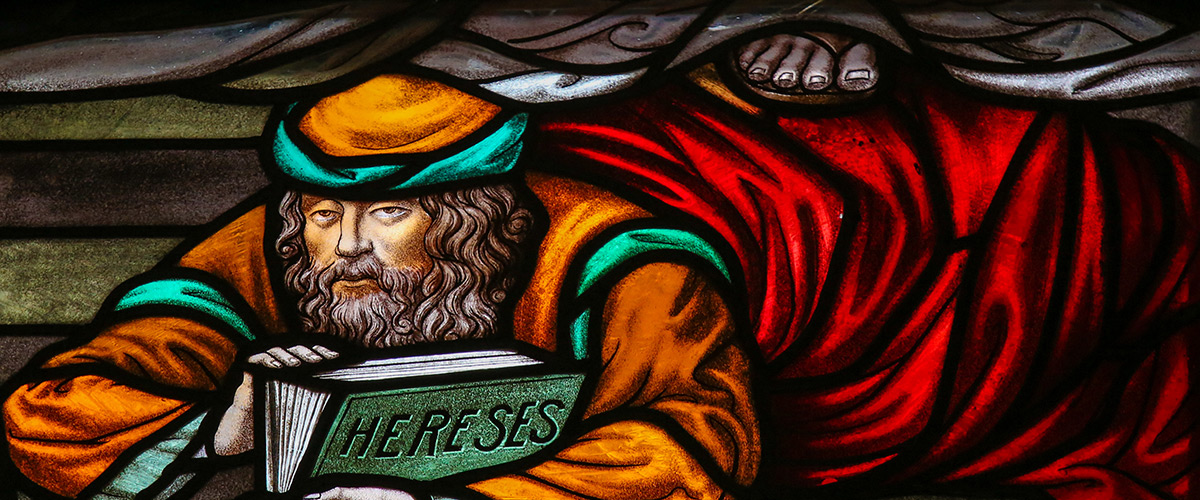The Early Heretics
By Martin Thielen
September 2, 2025

“Toward the end of the second century . . . those who identified themselves as Christians entertained many—and radically differing—religious beliefs and practices. . . . Yet by A.D. 200, the situation had changed. Christianity had become an institution . . . who understood themselves to be guardians of the only ‘true faith.’ The majority . . . rejected all other viewpoints as heresy.”
—Elaine Pagels, The Gnostic Gospels
I vividly remember the first time someone accused me of being a heretic. It occurred in a dorm room during my sophomore year of college. A fellow ministerial student and I were engaged in a spirited debate about biblical inspiration. Near the end of the conversation he asked me, “Do you believe in the infallibility and inerrancy of Scripture?” I replied, “No, I do not.” He called me a heretic, left the room, and never spoke to me again.
The last time someone accused me of being a heretic occurred several weeks ago. An unhappy Doubter’s Parish reader sent me an email about my recent article, Reading the Heretics. He said, “Your writing is going to send a lot of people to hell.” When I told him I didn’t believe in hell, he called me a heretic and unsubscribed from my newsletter.
In the decades between those two events (almost fifty years), I’ve often been called a heretic. In fact, when I launched Doubter’s Parish in 2020, I considered calling it “HereticPreacher.Com.” When people accuse me of heresy, it still stings a bit. But not much. Why? Because I’m in good company. “Heretics” (people who differ in opinion from established religious dogma) have been around since the beginning of religion. They were especially active during the first two hundred years of the Christian movement. Those early heretics are the focus of this month’s post.
The Myth of Early Theological Uniformity
This article depends heavily on Elaine Pagel’s groundbreaking publications (which I highly recommend), The Gnostic Gospels and Beyond Belief: The Secret Gospel of Thomas. Although they’ve been around for decades, I only recently read them. As you might guess, they were not on the recommended reading list at the two Southern Baptist seminaries I attended! In these seminal works, Pagel points out that the early Christian movement included significant theological diversity, as illustrated by the following quotes:
- “Early Christianity is far more diverse than nearly anyone expected before the Nag Hammadi (Gnostic Gospels) discoveries.”
- “Numerous gospels (beyond Matthew, Mark, Luke and John) circulated among various Christian groups.”
- “Many people have tried to impute a single, definitive meaning shared by all ‘early Christians,’ but first-century evidence . . . tells a different story.”
- “The astonishing discovery of ancient secrets gospels . . . has revealed a much wider range of Christian groups than we had ever known before.”
- “Instead of discovering the purer, simpler ‘early Christianity’ that many of us had been looking for, we found ourselves in the midst of a more diverse and complicated world than any of us could have imagined.”
In spite of popular belief, the early Christian movement did not have a unified, common, pure, standardized set of orthodox beliefs, practices, or sacred scriptures. There was no monolithic “New Testament Church” as I was taught to believe as a teenager.
Instead, great diversity ruled the day. And when an orthodox version of faith began to coalesce near the end of the second century, rogue voices and dissident doctrines were still common and popular. In short, the first two hundred years of Christianity included large numbers of “heretical” voices.
Examples of Early Theological Diversity
The theological divides during the first two hundred years of Christianity were not minor or subtle. Instead, they represented substantially different theological worldviews. Numerous (overly simplified) examples follow:
- Early “orthodox” Christians insisted that Jesus was divine. Early “heretical” Christians affirmed that Jesus, while enlivened and empowered by God, was still a man.
- Early “orthodox” Christians only accepted four Gospels (Matthew, Mark, Luke, and John). Early “heretical” Christians ascribed authority to a larger number of gospels.
- Early “orthodox” Christians believed in a literal resurrection of Jesus. Early “heretical” Christians claimed that the resurrection was a spiritual metaphor, not a physical reality. Similar dynamics existed around the belief in Jesus’s virgin birth.
- Early “orthodox” Christians affirmed biblical literalism, including God’s wrath. Early “heretical” Christians questioned biblical literalism, including acts of divine violence.
- Early “orthodox” Christians exclusively used masculine language and images to describe God. Early “heretical” Christians used masculine and feminine language and images to describe God. At the same time, they warned against literalizing anthropomorphic views of God and encouraged believers to embrace divine mystery and ambiguity.
- Early “orthodox” Christians insisted that people could only experience God externally, through Jesus Christ, Scripture, and the church. Early “heretical” Christians said people could also find God internally, through self-discovery of God’s image embedded within them.
- Early “orthodox” Christians believed women were inferior to men and could not hold church leadership. Early “heretical” Christians taught that men and women were equals and encouraged women to serve as ecclesiastical leaders.
Many other examples could be given. For example, early Christians held diverse and often conflicting interpretations concerning the sacraments of baptism and the Eucharist. In a nutshell, theological diversity in the early church was not the exception but the rule.
Of course, what was considered “orthodox” and “heretical” only became settled after the orthodox version gained the upper hand at the end of the second century. Before then, both “orthodox” and “heretical” versions of faith had large followings. And all of them identified as authentic and faithful Christian believers. However, after the orthodox version prevailed, the theological victors branded all divergent views as “lies, wickedness, blasphemy, and heresies” and sought to stamp them out, sometimes by violence.
Orthodoxy further strengthened its hand when the Roman emperor Constantine converted to Christianity, when the New Testament canon was set, when the church became more formally structured and institutionalized, and when the creeds of the fourth century (including the Nicene Creed) became the official theological doctrines of the Christian faith. However, while the orthodox version of Christianity became the dominant voice of the church, the heretics never fully went away.
The Need for Heretics
The rise of orthodoxy during the early centuries of the church—including canonical Scriptures, creeds, religious rituals, and clerical hierarchy—provided (and continues to provide) numerous advantages to the Christian religion. For example, it unified believers around common beliefs and practices. It helped the church appeal to the masses. It stabilized and consolidated a fragmented Christian movement. And the list of benefits goes on.
But the ascendence of orthodoxy also came (and continues to come) with a cost. It stifled dissent. It fostered rigidity. It outlawed honest questions about God and faith. It demonized doubt and glorified certainty. It created a culture of religious authoritarianism. It fostered intolerance. It led to persecution of non-Christian groups including Muslims and Jews. And, by condemning all nonorthodox thinkers as heretics, it turned away large numbers of religious doubters, seekers, and skeptics who struggled with orthodox theological views. In short, outlawing heresy impoverished the church on many levels.
Over the centuries, orthodox faith has proven adequate for the majority of believers. But not all of them. From the beginning, a significant minority of inquiring Christians has been unable to tow the “company line.” They ask hard questions. They question authority. And they point out inconvenient realities. Mostly, they seek to create an honest and authentic faith that makes sense to them, even if they have to draw outside the lines of traditional orthodoxy.
So while religious orthodoxy certainly has its advantages, there is still a need for “heretics” to challenge the status quo, to ask probing questions, to help people grapple with their faith, and to offer a minority view. Therefore, I find it encouraging to know that “heresy” and “heretics” have been around from the beginning of the Christian movement, that they continue to exist today, and that they still make important contributions to the Christian faith.
A Nonproselyting Heretic
Several weeks ago, I met a man who described himself as a “nonproselyting atheist.” He explained that while he doesn’t believe in God, he has no desire to win others to his side. Interestingly enough, this atheist, like many others, goes to church every Sunday, but that’s a story for another day.
I’ve thought a lot about this man’s self-identifying as a “nonproselyting atheist.” Although I am not an atheist, I could easily describe myself as a “nonproselyting heretic.” While I hold some “heretical” beliefs (along with orthodox ones), I have no need to evangelize others to my way of thinking. Instead, I seek to engage people who are already grappling with traditional faith, including the institutional church.
In short, I attempt to help thinking people navigate faith in the twenty-first century. In this way, I join a long (over two-thousand-year-old) tradition of “heretics” who, in spite of our heresy, still seek to love and follow Jesus and who attempt to help others do the same.
NOTE: For an overview of my “heretical” journey and beliefs, see my most recent (free) book, My Long Farewell to Traditional Religion and What Remains.
AUTHOR’S NOTE
To share this post, please click the appropriate icon at the bottom of the page. If you would like to communicate with me, feel free to send an email and I’ll respond as soon as possible. To receive my monthly newsletter (a brief email notification alerting you to new posts and other materials), please do so today. Thank you for your interest in Doubter’s Parish. Writing for you is a joy.
